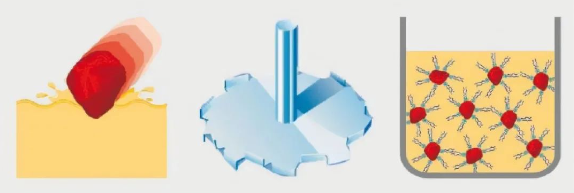修正原理
変性プラスチックとは、一般プラスチックやエンジニアリングプラスチックをベースに、充填、配合、強化等の方法により加工、改質し、難燃性、強度、耐衝撃性、靱性等の特性を向上させたプラスチックをいう。改質には、プラスチックの添加剤、改質プラスチック中の充填材の分散状態、およびその形成が含まれます。コンクリートに砂や砂利を加えるのと同じように、充填材も樹脂の界面構造に大きな影響を与えます。充填材の分散については以下で説明します。
分散状態
1. 無機粒子をポリマー溶融物に添加すると、無機粒子の分散微細構造は 3 種類存在します。 2 番目の凝集状態、この分散状態には優れた増強効果があります。 (2) 不規則な分散状態で、集団となって存在するものもあれば、個別に分散して存在するものもあります。この分散は強化も強化もされません。・マトリックス樹脂中に均一に分散。この場合、粒子とマトリックス樹脂の間に良好な界面があるかどうかに関係なく、一定の強化および靭性向上効果が得られます。強化および強化されたフィラー改質プラスチックを得るために、第 3 の分散状態が利用可能であることが望まれています。

浸漬・撹拌・分散工程
2. 無機粉末粒状充填材を単独でマトリックス樹脂中に均一に分散できるかどうかには、様々な要因が関係する。一定の処理条件の場合、期待される充填改質の効果から、無機粒子径は小さいほど良い。しかし、サイズが小さくなるほど表面エネルギーが高くなり、自己凝集能力が強くなり、均一に分散することが難しくなります。 「凝集」の効果は、高速運動による衝突や摩擦によって生じる表面エネルギーと静電気によって形成されます。この種の凝縮物は、その後の混合および成形加工において機械的剪断力によって開くことができなくなり、改質プラスチックの「ホワイト スポット」が最も見られにくい第 2 の不規則な分散状態を示します [38]。
梱包状態
粉末粒状とは、長径比がほぼ1となる充填材の分散状態であり、長径が比較的大きい充填材とは、短繊維状、針状、薄いシート状の充填材をいう。繊維状材料は優れた強化効果を持っていますが、ほとんどの繊維状充填材料は価格が高く、環境保護も不十分です。炭酸カルシウム繊維 (ウィスカー) の大量生産はこの状況を変える可能性があり、長いウィスカーは製紙業界の製紙繊維を減らすことさえできます。
修正されたアプリケーション
コストパフォーマンスに優れた改質プラスチックは、川下分野での応用が進んでいます。変性プラスチックは消費トレンドになっていると言え、その背景には次の 5 つの要因が示唆されています。
高性能: 改質プラスチックは、低密度や耐食性などの従来のプラスチックの利点を備えているだけでなく、高強度、高靭性、高耐衝撃性、耐摩耗性、耐震性などの優れた物理的および機械的特性も備えています。さらに、プラスチックの総合的な性能の向上は、下流分野での幅広い用途の基盤を提供します。[67]
低コスト: 他の材料と比較して、プラスチックは生産効率が高く、密度が低いという利点があり、コストが低くなります。プラスチックの単位体積当たりのコストは、金属の約 10 分の 1 にすぎません。[70]。
政府の政策: 中国はカタログ製品の安全性能を厳格に規定する「3C」強制認証制度を導入し、家電、IT、通信などにおける難燃性プラスチックの広範な応用を促進している。フィールド。
消費のアップグレード:生活水準の向上に伴い、人々はより優れた製品性能を追求し始め、家電製品やその他の製品はより美しく、安全で耐久性のあるものを求め、上流のプラスチック産業に対してより高い要求を提示し、次のようなものを要求しています。より優れた処理性能、機械的特性、耐久性、安全性。
技術的要因: 世界中で 1000 種類以上のポリマーが発見されていますが、実際に応用価値があるものはほんの数十種類だけです。新しいポリマーの開発には巨額の投資が必要なだけでなく、応用の見通しも不確実です。それどころか、改質技術は業界のニーズを満たすために既存のポリマーの特性を改善するだけでなく、一部の高価なエンジニアリングプラスチックのコストを削減することもでき、プラスチック産業を発展させる効果的な方法になります。[79]
硬度指数
「鉄をプラスチックに置き換える」傾向は多くの業界で現れており、硬度はその主な指標です。硬度は、他のより硬い物体によってその表面に押し付けられるのに抵抗する材料の能力を指します。硬度を示すために一般的に使用される方法がいくつかあります:
A.ショア硬度
B.ロックウェル硬度
c、モース硬度
改質プラスチックの硬度付与とは、プラスチックに硬質添加剤を添加する改質方法を指します。一般的に使用される硬質フィラーは、硬質無機フィラーおよび繊維です。
(1) 硬質無機フィラーを添加する
表面処理によりプラスチックの硬度が向上します
プラスチックの表面硬度向上方法とは、プラスチック製品の内部製品の硬度はそのままに、外表面の硬度を向上させることを指します。これは低コストで硬度を向上させる方法である
。
この改質方法は主に貝殻、装飾材料、光学材料、日用品などに使用されています。この改質方法には主に塗装、コーティング、表面処理が含まれる
。
(2) ブレンドによりプラスチックの硬度が向上します
プラスチックブレンドの改良された方法は、高硬度の樹脂を低硬度の樹脂に混合して全体の硬度を向上させることです。一般的なブレンドは PS、PMMA、ABS、MF などであり、改質が必要な樹脂は主に PE、PA、PTFE、PP です。
(3)複合改良プラスチックの硬度
プラスチック複合材料の硬度を向上させる方法は、硬度の低いプラスチック製品の表面に硬度樹脂の層を配合することです。主に板、シート、フィルム、パイプなどの押出成形品に適した工法です。一般的に使用される複合樹脂は、PS、PMMA、ABS、MF です。

厦門LFT複合プラスチック有限公司は、LFT&LFRTに焦点を当てたブランド企業です。 長ガラス繊維シリーズ (LGF) および長炭素繊維シリーズ (LCF)。同社の熱可塑性 LFT は、LFT-G 射出成形および押出成形に使用できるほか、LFT-D 成形にも使用できます。お客様のご要望に合わせて製作可能です。長さは5~25mmです。同社の長繊維連続浸透強化熱可塑性プラスチックは ISO9001&16949 システム認証に合格しており、製品は多くの国内商標と特許を取得しています。
タグ :